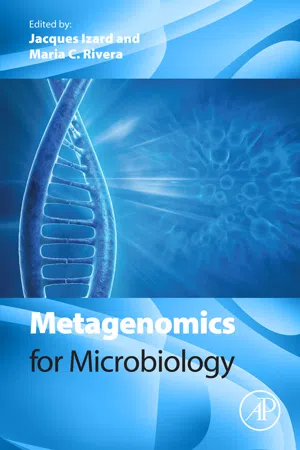
- 188 pages
- English
- ePUB (mobile friendly)
- Available on iOS & Android
Metagenomics for Microbiology
About this book
Concisely discussing the application of high throughput analysis to move forward our understanding of microbial principles, Metagenomics for Microbiology provides a solid base for the design and analysis of omics studies for the characterization of microbial consortia. The intended audience includes clinical and environmental microbiologists, molecular biologists, infectious disease experts, statisticians, biostatisticians, and public health scientists. This book focuses on the technological underpinnings of metagenomic approaches and their conceptual and practical applications.With the next-generation genomic sequencing revolution increasingly permitting researchers to decipher the coding information of the microbes living with us, we now have a unique capacity to compare multiple sites within individuals and at higher resolution and greater throughput than hitherto possible. The recent articulation of this paradigm points to unique possibilities for investigation of our dynamic relationship with these cellular communities, and excitingly the probing of their therapeutic potential in disease prevention or treatment of the future.- Expertly describes the latest metagenomic methodologies and best-practices, from sample collection to data analysis for taxonomic, whole shotgun metagenomic, and metatranscriptomic studies- Includes clear-headed pointers and quick starts to direct research efforts and increase study efficacy, eschewing ponderous prose- Presented topics include sample collection and preparation, data generation and quality control, third generation sequencing, advances in computational analyses of shotgun metagenomic sequence data, taxonomic profiling of shotgun data, hypothesis testing, and mathematical and computational analysis of longitudinal data and time series. Past-examples and prospects are provided to contextualize the applications.
Frequently asked questions
- Essential is ideal for learners and professionals who enjoy exploring a wide range of subjects. Access the Essential Library with 800,000+ trusted titles and best-sellers across business, personal growth, and the humanities. Includes unlimited reading time and Standard Read Aloud voice.
- Complete: Perfect for advanced learners and researchers needing full, unrestricted access. Unlock 1.4M+ books across hundreds of subjects, including academic and specialized titles. The Complete Plan also includes advanced features like Premium Read Aloud and Research Assistant.
Please note we cannot support devices running on iOS 13 and Android 7 or earlier. Learn more about using the app.
Information
Steps in Metagenomics: Let’s Avoid Garbage in and Garbage Out
Abstract
Keywords
Why metagenomics?
Table of contents
- Cover
- Title page
- Table of Contents
- Copyright
- List of Contributors
- Preface
- Chapter 1: Steps in Metagenomics: Let’s Avoid Garbage in and Garbage Out
- Chapter 2: Long-Read, Single Molecule, Real-Time (SMRT) DNA Sequencing for Metagenomic Applications
- Chapter 3: Ribosomal RNA Removal Methods for Microbial Transcriptomics
- Chapter 4: High-Throughput Sequencing as a Tool for Exploring the Human Microbiome
- Chapter 5: Computational Tools for Taxonomic Microbiome Profiling of Shotgun Metagenomes
- Chapter 6: Hypothesis Testing of Metagenomic Data
- Chapter 7: Longitudinal Microbiome Data Analysis
- Chapter 8: Metagenomics for Bacteriology
- Chapter 9: Toward the Understanding of the Human Virome
- Chapter 10: Promises and Prospects of Microbiome Studies
- Glossary
- Index